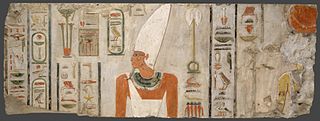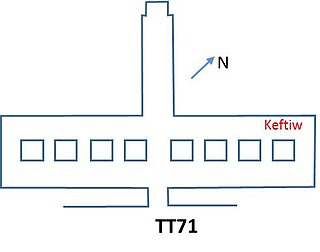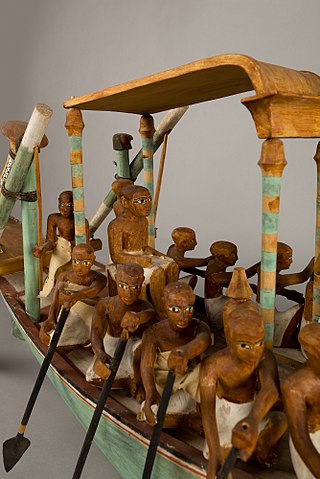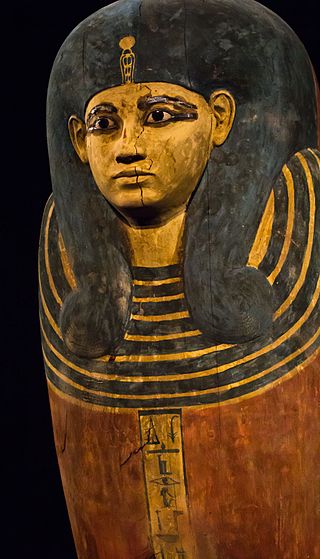
Deir el-Bahari or Dayr al-Bahri is a complex of mortuary temples and tombs located on the west bank of the Nile, opposite the city of Luxor, Egypt. This is a part of the Theban Necropolis.

Mentuhotep II, also known under his prenomen Nebhepetre, was an ancient Egyptian pharaoh, the sixth ruler of the Eleventh Dynasty. He is credited with reuniting Egypt, thus ending the turbulent First Intermediate Period and becoming the first pharaoh of the Middle Kingdom. He reigned for 51 years, according to the Turin King List. Mentuhotep II succeeded his father Intef III on the throne and was in turn succeeded by his son Mentuhotep III.

Theban Tomb TT71 is located in the Theban Necropolis, on the west bank of the Nile, opposite to Luxor. It was the tomb chapel of Senenmut, who was the steward and architect of Hatshepsut. The chapel is located in the necropolis area around Sheikh Abd el-Qurna. Previously the tomb was accessible and for most of this time the target of numerous investigations and intrusions, although early on already heavily destroyed. The tomb was visited already early. In the first half of the nineteenth century, John Gardner Wilkinson, Robert Hay and J. Wild copied scenes, although the decoration was already badly destroyed. Richard Lepsius (1842–45) took the false door to Berlin and copied some inscribed bricks. Only in 1906 Kurt Sethe copied all inscriptions. In 1930–31 Herbert Winlock cleared the whole tomb. Winlock found the fragments of a smashed sarcophagus.

The Valley of the Kings, also known as the Valley of the Gates of the Kings, is a valley in Egypt where, for a period of nearly 500 years from the 16th to 11th century BC, rock-cut tombs were excavated for the pharaohs and powerful nobles of the New Kingdom.
Herbert Eustis Winlock was an American Egyptologist and archaeologist, employed by the Metropolitan Museum of Art for his entire career. Between 1906 and 1931 he took part in excavations at El-Lisht, Kharga Oasis and around Luxor, before serving as director of the Metropolitan Museum from 1932 to 1939.

The ancient Egyptian official Meketre was chancellor and high steward during the reign of Mentuhotep II, Mentuhotep III and perhaps Amenemhat I, during the Middle Kingdom.

Theban Tomb TT2 is located in Deir el-Medina, part of the Theban Necropolis, on the west bank of the Nile, opposite to Luxor. It is the burial place of the ancient Egyptian official, Khabekhnet, and his family. Khabekhnet was Servant in the Place of Truth, during the reign of Ramesses II.

The Theban Tomb TT319 is located in Deir el-Bahari, part of the Theban Necropolis, on the west bank of the Nile, opposite to Luxor. The tomb belongs to the king's wife Neferu II, wife of the ancient Egyptian king Mentuhotep II. Neferu was the daughter of Queen Iah and Intef III.
The Theban Tomb of Meru TT240 is located in El-Assasif, Theban Necropolis. It overlooks the mortuary temple of the 11th Dynasty Pharaoh Mentuhotep II.
Ipi was an Ancient Egyptian vizier of the early Middle Kingdom. His only secure attestation known today is his Theban Tomb (TT315) .The tomb was found in the rocks of Deir el-Bahari overlooking the funerary complex of Mentuhotep II. It consisted of a great courtyard, a corridor, a chapel and a burial chamber. The corridor and chapel were found undecorated and only the burial chamber had painted decorations, religious texts and the titles and name of Ipi on its walls. The burial chamber housed a sarcophagus, sunk into the floor.

Dagi was an ancient Egyptian vizier during the reign of pharaoh Mentuhotep II of the Eleventh Dynasty.

Kheti was an ancient Egyptian treasurer of the 11th Dynasty, under king Mentuhotep II. Kheti appears in several sources and was one of the most influential figures at the royal court of the king. He is depicted in two rock reliefs at Shatt er-Rigal where he is standing in front of the king. Once the king wears the Sed festival dress. It can be assumed that Kheti was involved in arranging the festival for the king. His name and title appear in the funerary temple of the king in Deir el-Bahari and he had a tomb near the funerary temple of his king. The tomb (TT311) was found heavily destroyed but there are still many remains of reliefs showing that it was once decorated. The burial chamber was better preserved and was also decorated. His successor was Meketre.

The Theban Tomb TT214 is located in Deir el-Medina, part of the Theban Necropolis, on the west bank of the Nile, opposite to Luxor.

Khawy was a guardian in the Place of Truth and servitor of Amun of Opet (Luxor) from the reign of Ramesses II. He lived in the workers village Deir el-Medina. Khawy is known from his tomb TT214, his house and several other inscriptions.

Neferu II was the wife and sister of the ancient Egyptian king Mentuhotep II who ruled in the 11th Dynasty, around 2000 BC.

The Theban Tomb known as TT308 is located in Deir el-Bahari. It forms part of the Theban Necropolis, situated on the west bank of the Nile opposite Luxor. The tomb is the burial place of the Ancient Egyptian Kemsit, who was King's Beloved Wife, King's Ornament, King's Sole Ornament, Priestess of Hathor during the reign of Mentuhotep II, in the 11th dynasty.

The Theban Tomb known as MMA 57 is located in Deir el-Bahari. It forms part of the Theban Necropolis, situated on the west bank of the Nile opposite Luxor. The tomb is likely the burial place of the Ancient Egyptian Harwa.

The Theban Tomb known as MMA 507 is located in Deir el-Bahari. It forms part of the Theban Necropolis, situated on the west bank of the Nile opposite Luxor. The tomb is the burial place of approximately 60 slain soldiers dating to the 12th Dynasty.

The Theban Tomb TT358 is located in Deir el-Bahari, part of the Theban Necropolis, on the west bank of the Nile, opposite to Luxor. The tomb belongs to the king's wife Ahmose-Meritamun, the sister and the wife of Pharaoh Amenhotep I. The tomb was later used for the additional burial of the King's daughter Nany, who was a daughter of Pharaoh Pinedjem I.
North Asasif – is a part of the Theban Necropolis located on the bottom and sides of the valley, along the processional ways leading to the royal temples in Deir el-Bahari: temples of Mentuhotep II, Hatshepsut, and Thutmose III. It encompasses private tombs dating from the Middle Kingdom to the Ptolemaic period. Evidence has been found of strong ties between Asasif and Deir el-Bahari through the ages.



















